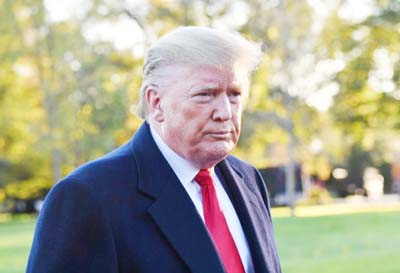
After announcing his intention to leave the Paris climate accord back in 2017, Donald Trump is expected on Monday to send a letter that will trigger a yearlong countdown before the US can formally exit.
But although his administration has largely ignored the landmark agreement since taking power, American officials will continue to play a role in negotiating technical details – just in case they ever want to come back.
“Because of the historical role the US has played, especially on issues like transparency, other governments will continue to hear them out and allow them to play something of a role,” David Waskow, an expert on climate negotiations at the World Resources Institute in Washington, told AFP.
Though the landmark accord went into effect for nearly 200 nations in 2016, various technical aspects over its implementation remain to be ironed out including matters of accounting for emissions and how much data countries will be required to publish.
The State Department told AFP it will send a delegation to the next major UN climate summit, the COP25, in Madrid – just like it has for every previous such summit since Trump took power.
Article 28 of the 2015 agreement says signatories can only formally ask to leave three years after it takes force, meaning November 4, 2019.
That would mean that the US will remain a signatory until November 4, 2020 – the day after the next presidential election.
The official letter has long been expected and won’t mean anything in concrete terms, but will send a strong signal to the Republican president’s base on the campaign trail.
“It wouldn’t be surprising to see him try to use this politically,” said Waskow.
·Trump’s initial announcement that he was pulling the world’s number two polluter out of the accord triggered uncertainty over its future – but so far no other country has followed the United States’s lead.
Brazil remains in, despite the election of climate skeptic Jair Bolsonaro, and other big emitters like China, India and South Africa also remain engaged in the process, even if their targets are for the time being deemed insufficient. Even Russia, which has long given short shrift to climate policy, finalized its participation in September.
Trump’s climate nihilism has also had an unintended effect: the emergence of non-federal actors setting their own targets.
“Here at home, states, cities and businesses representing more than half of the US GDP and population have committed to take action to meet the Paris Agreement’s goals,” said Alden Meyer, another climate negotiations expert, from the Union of Concerned Scientists in Washington.
Depending on how you look at it, such efforts represent a half-full or half-empty glass.
The combined reduction targets of California, New York state, multi-billion dollar corporations and more aren’t negligible, but they don’t compensate for inaction at the federal level.
For example, Obama had set ambitious auto emissions reduction targets, since rolled back by Trump.
Obama’s overall greenhouse gas reduction target for 2030 was a relatively modest 26 percent drop compared to 2005 levels, but even that is projected to be missed by about a third, according to an estimate published by the organization America’s Pledge, and which will next be updated in December.

